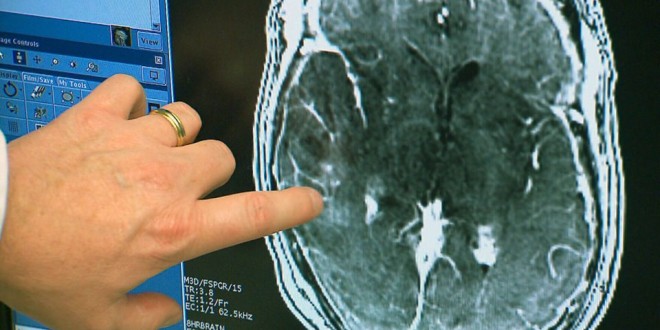Sunnybrook researchers made history this week as they used focused ultrasound to non-invasively breach the blood-brain barrier and more effectively deliver chemotherapy into the brain tumour of a patient.
Each person has a protective barrier that normally restricts the passage of substances from the bloodstream into the brain protecting it from toxic chemicals.
“The blood-brain barrier (BBB) has been a persistent obstacle to delivering valuable therapies to treat disease such as tumours,” says Dr. Todd Mainprize, principal investigator of the study and Neurosurgeon in the Hurvitz Brain Sciences Program at Sunnybrook Health Sciences Centre.
“We are encouraged that we were able to temporarily open this barrier in a patient to deliver chemotherapy directly to the brain tumour.”
The research team infused a chemotherapy drug, then tiny, microscopic bubbles, into the bloodstream of a patient with a malignant brain tumour. The microbubbles are smaller than red blood cells and pass harmlessly through the circulation. The researchers then used state-of-the-art MRI-guided focused low-intensity ultrasound (sound waves) to target blood vessels in the BBB area near the tumour. The waves repeatedly compress and expand the microbubbles, causing them to vibrate and loosen tight junctions of the cells comprising the BBB. Once the barrier was opened, the chemotherapy flowed through and deposited into the targeted regions.
“Some of the most exciting and novel therapeutics for the treatment of malignant brain tumours are not able to reach the tumour cells because of the blood brain barrier. This technique will open up new opportunities to deliver potentially much more effective treatments to the targeted areas,” says Dr. Todd Mainprize, also an Assistant Professor in the Division of Neurosurgery at University of Toronto.
Dr. Kullervo Hynynen, Director of Physical Sciences at Sunnybrook Research Institute, worked with industry partner Insightec for almost two decades to develop the technology and bring it to a clinic-ready state. “The success of this case is gratifying,” he says. “My hope now is that many patients will eventually benefit from it.”
Less than 24 hours after breaching the blood brain barrier, the tumour and some surrounding tissues were surgically removed and sent to pathology to measure differences in the concentration of chemotherapy that deposited in the area treated by the focused ultrasound and the area not treated.
“Breaching this barrier opens up a new frontier in treating brain disorders,” says Dr. Neal Kassell, chairman of the Focused Ultrasound Foundation. “We are encouraged by the momentum building for the use of focused ultrasound to non-invasively deliver therapies for a number of brain disorders.”
The success of this research opens up the potential for delivering drug therapies to parts of the brain protected by the blood brain barrier, including researching treatments for patients with various kinds of brain tumours, Alzheimer’s disease, and some psychiatric conditions.
“This is a very important step in the development of MR-guided focused ultrasound technology,” says Eyal Zadicario, VP R&D and Director of Neuro Programs at Insightec. “We continue to push the technology into new clinical applications that can have significant impact where it matters most — to patients.”
This case was the first of up to 10 participants in this study, which is testing for feasibility, safety and preliminary efficacy. The participants are those already scheduled for traditional neurosurgery to remove parts of their brain tumour.
Agencies/Canadajournal
 Canada Journal – News of the World Articles and videos to bring you the biggest Canadian news stories from across the country every day
Canada Journal – News of the World Articles and videos to bring you the biggest Canadian news stories from across the country every day




Some 25-years ago, when my husband was having treatments for ALL leukemia, he had a “medical accident”. The radiation broke open the blood brain barrier and the brain, acting like a sponge, soaked up an uncontrolled dose of chemotherapy drugs causing a brain injury. I sincerely hope that these patients receive lifelong follow up and tracking in case unexpected side effects present themselves in the future. In our experience, my husband got his “golden handshake” from the cancer centre after 5-years. When he began to experience a host of health problems which included walking & balance problems, incontinence, and memory problems, the cancer centre would not see him because he didn’t have cancer, and it took almost a decade to get this diagnosis. We were told, “They didn’t know then, what they know now.” My husband outlived his original prognosis by 29-years and I thank the medical community for that. But, essentially we were left on our own for much of this time to search for the causes of his health problems and treatment. I hope differently for these patients and their families. They deserve better. May they find the strength to deal with whatever lies ahead. Best wishes!